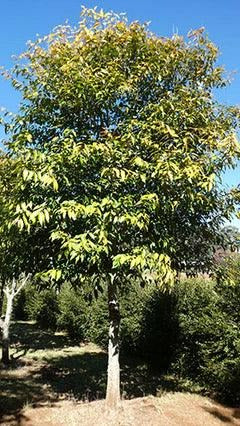Syzygium tierneyanum – River Cherry or Bamaga Satinash
The Syzygium tierneyanum, commonly known as River Cherry or Bamaga Satinash, is a fast-growing, evergreen tree native to northern Australia. Known for its glossy green foliage, clusters of fluffy white flowers, and small edible red berries, this ornamental tree is an excellent choice for tropical and subtropical gardens. Its dense canopy and adaptability make it perfect for shade, screening, or feature planting.
Specifications:
- Height: 6–12 meters
- Width: 3–6 meters
- Native to: Australia (Queensland, northern regions)
- Foliage: Glossy green leaves; evergreen
- Growth rate: Fast
Conditions:
- Soil: Prefers well-drained soils; tolerates sandy, loamy, and clay conditions
- Light: Full sun to partial shade
- Water: Moderate to high; thrives in consistently moist soil
- Climate: Thrives in tropical and subtropical regions
Additional Features:
- Flowers: Clusters of fluffy white flowers in spring and summer, attracting pollinators
- Fruit: Small, edible red berries that ripen in summer, used in jams and desserts
- Form: Dense, rounded canopy with upright growth
- Uses: Ideal for shade, screening, hedging, or as a feature tree
- Spacing: Plant 3–5 meters apart for screening or 6 meters apart as standalone specimens
- Low Maintenance: Requires minimal pruning; remove lower branches for canopy clearance if desired
- Pest Resistance: Generally pest-free and hardy
- Drought Tolerance: Moderate once established; benefits from supplemental watering in dry periods
- Frost Sensitivity: Protect from frost in cooler climates
- Wildlife Attraction: Flowers and fruit attract birds, bees, and other pollinators
- Erosion Control: Effective for stabilizing riverbanks and moist soil areas
- Seasonal Appeal: Evergreen foliage with seasonal flowers and fruit
The River Cherry is a versatile and attractive tree that enhances landscapes with its lush greenery, fragrant flowers, and edible fruit. Its hardiness and fast growth make it an excellent choice for gardens, parks, and revegetation projects.
The Benefits Of Buying An Advanced Tree
The Process Of Transplanting A Mature Tree
Identify the Tree's Root Zone
Identify the Tree's Root Zone
Before you begin, it's essential to identify the root zone or root ball of the tree. This is the area where the majority of the tree's feeder roots are located. It is typically estimated as 1 foot of root ball diameter for each inch of tree trunk diameter.
Prune the Roots
Prune the Roots
Root pruning should occur a few months before the actual move, ideally in the dormant season. This involves cutting a trench around the root zone to encourage the growth of new feeder roots, which will help the tree to establish itself in its new location.
Prepare the Tree
Prepare the Tree
Prior to digging, prune dead or excessive branches from the tree. This reduces the tree's overall mass, making it easier to handle, and decreases water loss post-transplant.
Dig Around the Root Ball
Dig Around the Root Ball
After determining the root ball's size, begin digging around it. Try to retain as much soil around the roots as possible. The depth should ideally get under the root system but be feasible for lifting.
Undercut the Root Ball
Undercut the Root Ball
Once you've dug around the periphery of the root ball, begin undercutting to sever the remaining roots beneath it.
Lift the Tree
Lift the Tree
With the root ball freed, carefully lift the tree out of the hole. For large trees, this will likely require machinery like a tree spade or crane. Always lift the tree by the root ball, not the trunk.
Prepare the Tree for Transport
Prepare the Tree for Transport
Once the tree is out of the ground, it's critical to protect the root ball to prevent damage. Wrap it in burlap and secure it with twine, wire or steel basket. This not only holds the root ball together but also helps retain moisture.
Water the Root Ball
Water the Root Ball
Prior to transportation, water the root ball thoroughly to ensure the roots stay moist.
Transporting the Tree
Transporting the Tree
Load the tree carefully onto a truck or trailer for transport. The tree should be securely positioned to avoid damage during transit. The tree should ideally be planted in its new location as soon as possible to minimize stress and increase its chance of survival.


